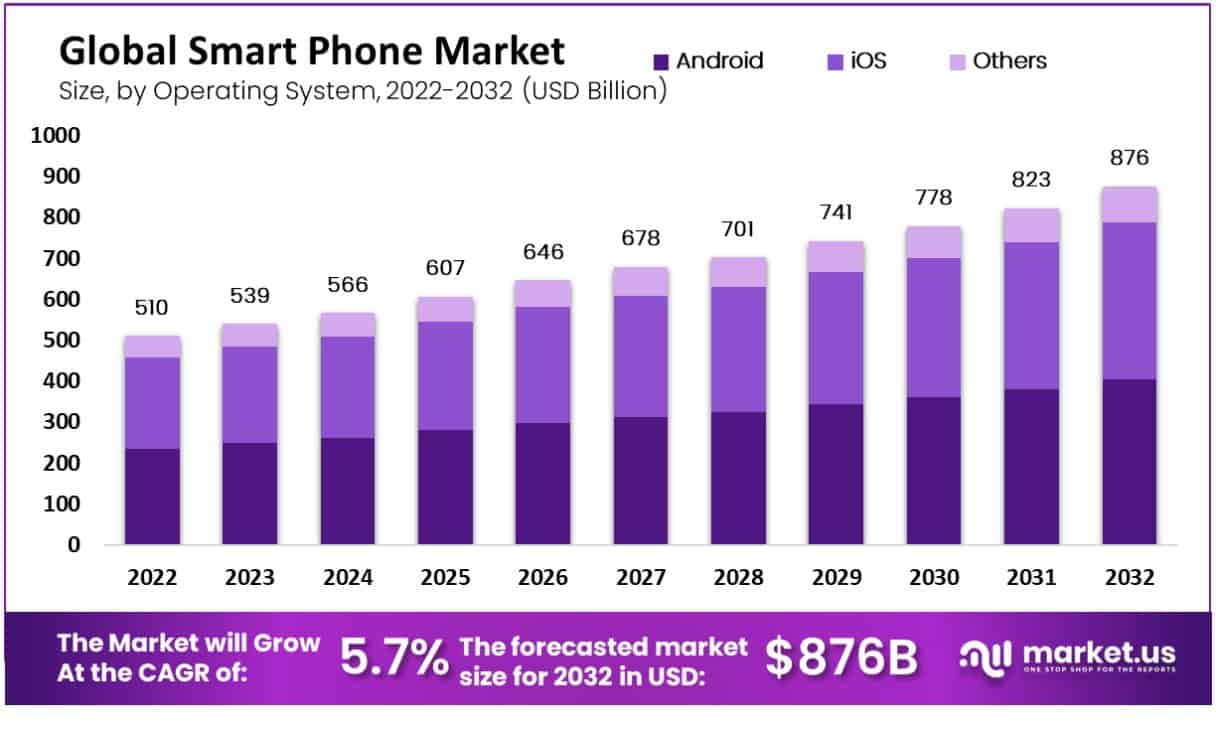Table of Contents
Introduction
According to Smart Phone Statistics, The smartphone market has witnessed exponential growth, driven by advancements in technology and changing consumer behaviors.
Key propelling factors include the integration of artificial intelligence (AI), and the expansion of 5G connectivity. The increasing demand for mobile applications that enhance user experience and productivity.
However, this growth is restrained by concerns over data privacy, security vulnerabilities, and the environmental impact of electronic waste.
Despite these challenges, the industry continues to innovate, with developments in foldable displays, improved battery life, and enhanced camera technologies marking significant advancements.
These innovations not only cater to the evolving needs and preferences of consumers but also underscore the smartphone’s role as an indispensable tool in the digital age, setting the stage for future technological breakthroughs and market expansion.
Editor’s Choice
- The global smartphone market was initiated in 2014 with 1.20 billion units sold, marking the onset of a digital era propelled by mobile connectivity.
- Starting with 4.53 billion users in 2015, there was a steady yearly rise, signifying greater accessibility and affordability of smartphones.
- China leads the global smartphone market with 911.92 million users, demonstrating its technological advancement and widespread adoption.
- In 2016, the World population was 7.464 billion with smartphone users of 4.70 billion and a penetration rate of 62.97%. Signaled significant mobile connectivity expansion globally.
- India follows with 20,064 million units showcasing its emerging role in international trade and manufacturing sectors.

Global Smart Phones Industry Overview
Market Global Smartphone User Growth
- Consistent growth in the global smartphone user base from 2015 to 2020 highlights an increasing dependency on mobile technology.
- Starting with 4.53 billion users in 2015, there was a steady yearly rise, signifying greater accessibility and affordability of smartphones.
- By 2016, the number rose to 4.7 billion, emphasizing the rapid adoption of smartphones across varied global demographics.
- The trend persisted into 2019, with the user base growing to 5.13 billion, illustrating the ongoing advancement of smartphone technology and its essential role in everyday life.
- The increase to 5.22 billion users by the end of 2020 highlights smartphones’ crucial function in promoting connectivity, supporting digital economies, and narrowing the digital divide.

Global Number of Smartphones Traded
- The global smartphone market was initiated in 2014 with 1.20 billion units sold, marking the onset of a digital era propelled by mobile connectivity.
- Sales surged to 1.42 billion in 2015, driven by enhanced smartphone features and greater internet accessibility.
- Continued growth in 2016 and 2017, reaching 1.49 and 1.54 billion respectively, reflected advancements in device performance and digital service facilitation.
- A slight increase to 1.56 billion in sales in 2018 highlighted market maturity and the importance of innovation and brand loyalty.
- By 2021, sales peaked at 1.59 billion, evidencing the industry’s ongoing innovation and smartphones’ essential role in global connectivity and empowerment.

Top 10 Smartphone Users Countries
- China leads the global smartphone market with 911.92 million users, demonstrating its technological advancement and widespread adoption.
- India’s 439.42 million users underscore its digital revolution, fueled by a tech-savvy middle class and affordable smartphones.
- The United States, with 270.00 million users, shows high penetration and demand for connectivity in a mature market.
- Indonesia’s young population drives its 160.23 million users towards mobile technology for various digital activities.
- Brazil, with 109.34 million users, highlights mobile technology’s role in its social and economic spheres.
- Russia’s 99.93 million users reflect strong smartphone demand, supported by extensive internet infrastructure.
- Japan integrates advanced technology into daily life, as evidenced by its 75.77 million smartphone users.

Global Smartphone Penetration Trends
- In 2017, the population was 7.548 billion with smartphone users of 4.86 billion and a penetration rate of 64.39%. Demonstrated ongoing trend towards increased smartphone adoption.
- In 2018, the population was 7.631 billion with smartphone users of 5.00 billion and a penetration rate of 65.52%. Marked notable milestone in global mobile technology prevalence.
- In 2019, the population was 7.713 billion with smartphone users of 5.13 billion and a penetration rate of 66.51%. Highlighted the growing reliance on smartphones for communication and digital access.
- In 2020, the population was 7.795 billion with smartphone users of 5.22 billion and a penetration rate of 66.97%. Emphasized the sustained upward trajectory of global smartphone adoption, underscoring their indispensable role in modern society.

Top 10 Smartphones Exporting Nations
- China leads in export shipments with a significant 93,850 million units reflecting its immense manufacturing capacity and global economic influence.
- India follows with 20,064 million units showcasing its emerging role in international trade and manufacturing sectors.
- Hong Kong contributes 6,189 million units leveraging its strategic location and robust business infrastructure.
- South Korea demonstrates considerable export strength with 4,673 million units driven by advanced technology and manufacturing prowess.
- Vietnam shows growth in exports with 2,514 million units buoyed by a burgeoning manufacturing sector and favorable trade agreements.
- The United States maintains a presence with 670 million units highlighting its enduring position as a major player in global trade.

Top 10 Smartphones Importing Nations
- India leads in import shipments with a substantial 62,049 million units reflecting its demand for foreign goods and materials to support its diverse economy.
- Vietnam follows with 12,627 million units indicating its increasing reliance on imports to fuel its manufacturing and industrial sectors.
- Pakistan shows significant import activity with 11,651 million units underscoring its need for external resources to meet domestic demands.
- United Arab Emirates maintains a strong import profile with 10,598 million units driven by its role as a global trade hub and diversified economy.
- Bangladesh records 6,889 million units in import shipments, highlighting its dependence on foreign products to sustain its growing economy.
- Peru, the United States, and Colombia, each contribute substantially with import shipments ranging from 5,484, 5,335 to 3,864 million units reflecting their respective trade dynamics and economic needs.

Consumer Behavior Trends in Smartphones Statistics
Age
- 18-29 Age Group: Almost all individuals in this age range, 99%, own a cellphone, with 97% using smartphones, while only 1% use a cellphone without smartphone capabilities.
- 30-49 Age Group: Similar to the younger demographic, 99% of individuals in this age bracket possess cell phones, with 97% utilizing smartphones. However, a slightly higher percentage, 2%, still use cell phones without smartphone features.
- 50-64 Age Group: While cellphone ownership remains high at 98%, the percentage of smartphone users drops to 89%. Notably, 8% of individuals in this age group still rely on cell phones without smartphone functionalities.
- 65+ Age Group: Cellphone ownership decreases to 94% in this older demographic, with only 76% using smartphones. A significant portion, 17%, continue to use cell phones without smartphones, reflecting a preference for more traditional devices among some elderly individuals.

Gender
- Men and women show high cellphone ownership, with 97% in each group.
- Smartphone usage is prevalent, with 91% of men and 90% of women owning one.
- A small but notable percentage, 6% of men and 7% of women use cell phones exclusively without smartphones.
- Overall, mobile device adoption is widespread.

Community
- Across urban, suburban, and rural areas, cellphone ownership remains consistently high, ranging from 97% to 98%.
- Smartphone adoption is also prevalent, with slightly lower rates in rural communities (87%) compared to urban and suburban areas (91-93%).
- Notably, a greater proportion of rural residents (10%) use cell phones without smartphones, compared to their urban and suburban counterparts (5-6%).

Discuss Your Needs With Our Analyst
Please share your requirements with more details so our analyst can check if they can solve your problem(s)





